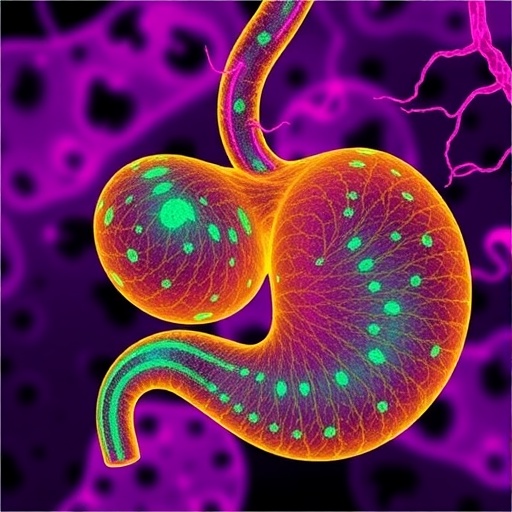
Pancreatic ductal adenocarcinoma (PDAC) stands as one of the deadliest malignancies globally, notorious for its aggressive invasiveness, late diagnosis, and grim prognosis. Representing the predominant subtype of exocrine pancreatic tumors, PDAC originates predominantly from the pancreatic ductal epithelium or acinar cells, transitioning through a precursor lesion before evolving into a full-fledged malignancy. Despite advances in oncology, five-year survival rates remain dismal at approximately 11%, largely due to diagnostic challenges, therapeutic resistance, and the complex biology underlying PDAC’s progression. Recent research has spotlighted the Hippo signaling pathway, particularly the role of its downstream effectors YAP and TAZ, as a critical modulator in pancreatic tissue homeostasis, tumor initiation, progression, and metastasis, offering promising avenues for innovative treatment strategies.
At the cellular genesis of PDAC, distinct pathways govern the transformation of the pancreas’ acinar and ductal cells. Ductal cell-derived PDAC often arises swiftly from oncogenic mutations in critical genes like KRAS and TP53, directly instigating invasive carcinoma. Contrastingly, acinar cells undergo a complex metaplastic process known as acinar-to-ductal metaplasia (ADM) under inflammatory or oncogenic influences. ADM marks the earliest pre-neoplastic lesion in PDAC, where acinar cells transdifferentiate into ductal-like cells, setting the stage for pancreatic intraepithelial neoplasia (PanIN). These early lesions can eventually culminate in invasive cancer. Intriguingly, sustained oncogenic pressure, such as the coexistence of GNAS and KRAS mutations, can induce the formation of intraductal papillary mucinous neoplasms (IPMNs) from acinar cells, which may further progress to PDAC, underscoring the diverse cellular origins and molecular pathways driving tumorigenesis.
Central to the regulation and disruption of these transdifferentiation and oncogenic processes is the Hippo signaling cascade. This pathway functions as a pivotal growth and proliferation controller through a kinase cascade that inhibits YAP and TAZ by phosphorylation. In PDAC, aberrant regulation of Hippo signaling leads to unchecked YAP/TAZ activation, driving neoplastic transformation and progression. Experimental models reveal that YAP/TAZ are indispensable for the initiation of ADM and PanIN lesions, particularly within contexts of pancreatitis and mutant KRAS expression. Notably, YAP/TAZ induce the upregulation of STAT3 and LIFR via TEAD transcription factors, amplifying inflammatory signaling and cellular plasticity necessary for early tumorigenesis. However, divergent findings in different models point to a nuanced role of YAP/TAZ that may vary depending on genetic and environmental contexts, signaling a need for further research.
.adsslot_L1ovqgy90j{width:728px !important;height:90px !important;}
@media(max-width:1199px){ .adsslot_L1ovqgy90j{width:468px !important;height:60px !important;}
}
@media(max-width:767px){ .adsslot_L1ovqgy90j{width:320px !important;height:50px !important;}
}
ADVERTISEMENT
Moving beyond initiation, the progression and maintenance of PDAC are tightly governed by Hippo pathway components, especially YAP, which acts as a master transcriptional regulator. Downregulation of upstream Hippo kinases such as MST1, MOB1, and NF2 has been observed in PDAC tumor tissues, suggesting their tumor-suppressive roles are compromised during cancer development. The reduced MST1 expression inhibits caspase-1 mediated pyroptosis, facilitating tumor cell survival. Meanwhile, repressive modifications by epigenetic regulators like KDM2B decrease phosphorylation of LATS kinases, thereby liberating YAP/TAZ to translocate to the nucleus and promote oncogenic gene expression. These molecular alterations underscore how tumors rewire Hippo signaling to sustain proliferative and survival signals.
A complex crosstalk exists between Hippo and other oncogenic signaling pathways within PDAC cells. For example, the MAPK pathway, downstream of KRAS mutations, intersects with Hippo signaling to mediate YAP activation. Other factors, including TGF-β and WNT5A, modulate YAP activity either by direct intervention in its phosphorylation state or by facilitating its nuclear retention, augmenting transcriptional programs favoring tumor growth and stromal interactions. This interplay broadens the oncogenic landscape of PDAC, implicating YAP/TAZ not only in tumor cell intrinsic proliferation but also in reshaping the tumor microenvironment.
Indeed, the tumor microenvironment in PDAC is a dense, complex milieu composed of stroma, cancer-associated fibroblasts (CAFs), immune cells, and extracellular matrix components that reciprocally communicate with neoplastic cells. YAP’s role extends to mediating the crosstalk between cancer cells and stromal partners. It promotes the secretion of paracrine factors such as CTGF, IL-6, and MMP7 that activate pancreatic stellate cells (PSCs), a major source of CAFs, which in turn remodel the extracellular matrix to reinforce tumor growth and therapy resistance. These bidirectional interactions facilitated by YAP empowerment underscore why PDAC is notably resistant to conventional therapies and prone to recurrence.
Metastasis, the primary cause of PDAC-related mortality, is intimately linked with epithelial-mesenchymal transition (EMT), a process substantially influenced by Hippo signaling perturbation. The inhibition or loss of Hippo kinases like MST2 and NF2 results in enhanced YAP/TAZ activity, driving EMT through direct transcriptional regulation of genes involved in cell adhesion, migration, and invasion. Additionally, metabolic reprogramming via pathways such as the pentose phosphate pathway (PPP) is regulated by Hippo components, providing cancer cells with anabolic precursors and redox balance essential for metastasis and survival in hostile microenvironments. Intracellular and extracellular factors, including microRNAs modulated by ZIP4 and acidosis-induced YAP activation, further facilitate metastatic dissemination through EMT plasticity.
Perhaps most compellingly, emerging evidence implicates YAP amplification as a key driver of PDAC recurrence following targeted therapy cessation. Studies utilizing inducible KRAS mutant models reveal that while initial tumor regression occurs upon KRAS extinction, a significant proportion of tumors relapse through either reactivation of KRAS mutations or YAP overexpression independent of KRAS signaling. The YAP/TEAD2–E2F axis governs the transcription of genes essential for cell cycle progression and DNA replication in relapsed PDAC, effectively substituting for oncogenic KRAS. These findings highlight the necessity of targeting YAP to combat PDAC relapse, which remains a major obstacle in successful patient management.
Given the centrality of YAP in the malignancy spectrum of PDAC, therapeutic efforts have increasingly focused on modulating Hippo pathway effectors. Pharmacological inhibitors like verteporfin disrupt the interaction between YAP and TEAD transcription factors, impeding the transcription of oncogenic programs and inhibiting PDAC cell proliferation and survival in preclinical studies. Another promising approach involves VGLL4-mimicking peptides that competitively bind TEADs, preventing YAP-driven transcription. Although tyrosine kinase inhibitors such as dasatinib and pazopanib also enhance YAP phosphorylation and reduce its nuclear localization, their clinical efficacy specifically in PDAC remains to be validated, warranting further investigation.
Therapeutic resistance in PDAC poses an enormous challenge that may be countered by combinatorial approaches targeting both Hippo pathway downstream effectors and upstream oncogenic drivers like KRAS. Dual inhibition strategies aimed at both YAP/TEAD and YAP/AP-1 complexes could more effectively suppress tumor growth and overcome monotherapy resistance. The development and refinement of such therapies require deeper understanding of the molecular interplay governing Hippo signaling dynamics and its cross-regulatory networks, particularly in the context of genetic heterogeneity and tumor microenvironment complexity.
Overall, the Hippo signaling pathway emerges as a linchpin in pancreatic tissue homeostasis and PDAC pathogenesis, orchestrating the transition from normal pancreatic cells through various pre-neoplastic lesions to invasive and metastatic disease. Unraveling the intricate regulatory networks of Hippo kinases and their downstream transcriptional co-activators offers unprecedented potential for the design of treatments that not only impede tumor growth but also forestall metastasis and disease recurrence. As PDAC continues to inflict high mortality worldwide, leveraging the therapeutic vulnerabilities within the Hippo pathway could redefine clinical management and improve outcomes for patients afflicted with this formidable malignancy.
Subject of Research: Pancreatic ductal adenocarcinoma and the role of Hippo signaling pathway in its pathogenesis.
Article Title: The Hippo signaling pathway modulates pancreatic tissue homeostasis.
Article References:
Wang, X., Du, J., Li, H. et al. The Hippo signaling pathway modulates pancreatic tissue homeostasis. Cell Death Discov. 11, 343 (2025). https://doi.org/10.1038/s41420-025-02636-0
Image Credits: AI Generated
DOI: https://doi.org/10.1038/s41420-025-02636-0
Tags: acinar-to-ductal metaplasia in pancreasearly lesions in pancreatic cancerHippo signaling pathway in pancreatic cancerinflammatory processes in pancreatic cancer developmentinnovative treatment strategies for pancreatic canceroncogenic mutations in PDACpancreatic cancer prognosis and survival ratespancreatic ductal adenocarcinoma treatmentrole of KRAS and TP53 in pancreatic tumorstherapeutic resistance in PDACtumor microenvironment in pancreatic cancerYAP and TAZ in PDAC progression





